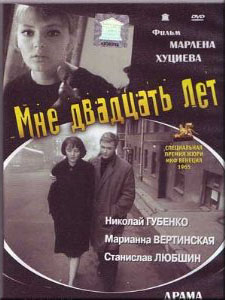
Soviet filmmakers were often criticized in the West for producing stories sneeringly termed “boy gets tractor, meets girl.” The USSR did indeed produce films that portrayed heroism in the construction of a socialist society, such as The Shinning Path (1941) and films that portrayed revolutionary struggle, such as Sergei Eisenstein’s October (1928) which, incidentally is scheduled to be screened this January at the Gene Siskel Film Center in Chicago.
But in addition to the heroic worker and revolutionary vanguard genre of films the Soviet studios also produced candid dramas concerning the lives of ordinary workers. It is this sort of film that was often the most compelling. A handful of these films received a limited distribution in the United States at the time of their original release. Perhaps the best known to western audiences is Moscow Does Not Believe in Tears (1980) which walked away with the Academy Award Oscar for best foreign language film. Less known however, and now available on DVD, is the 1966 film I Am Twenty.
The film, utilizing the talents of cinematographer Margarita Pilikhina, is shot on location in Moscow and provides us with many unique glimpses of the city, including a memorable scene in which the protagonist pursues the object of his affections through the crowd at the annual May Day parade.
The film is pitch perfect in its portrayal of youth. The 20-year-old to whom the title refers is the character Sergei and what happens to him in the course of the film is what happens to many of the rest of us in our own lives. He returns home from the Army, he acquires the job he desires, which is socially useful, but one he comes to find is not particularly fulfilling. He pursues the opposite sex, and shares in the everyday travails of his friends. Perhaps just as interesting for viewers who were raised in capitalist countries are the problems the character doesn’t face as the result of his residing in a socialist society.
So much of Soviet culture is on display in the film, perhaps a good deal of it unwittingly, that it serves as something of a time capsule and anthropological artifact. The examples range from the picture of poet Vladimir Mayakovsky on the wall of the family apartment to Sergei’s casual reference to his position as an “agitator,” which in the USSR was a neighborhood volunteer who helped get out the vote on election day. For those who spent time in the Soviet Union it will all be warmly familiar. The faultless acting makes I Am Twenty very genuine – nothing appears false, forced or over the top. We the audience are simply witnesses, a fly on the wall in a very human drama. And the camerawork that guides us through Moscow as the seasons change is almost lyrical in its urban beauty.
Perhaps the finest moment of the film comes when Sergei attends a party of young, elite intellectuals. During the course of the evening he finds himself bored and annoyed in equal measure. When one guest puts on a phonograph album of sentimental Russian songs the others express their distaste. Sergei on the other hand takes the opportunity to come out of his shell, expressing his patriotism in the process. When he is challenged, he succinctly rattles off a litany of the sweet successes of Soviet society, as well as the bitter defeats, and makes clear what his core values are. He then slips on his coat and descends the stairs out of the party, leaving the self-important dilettantes behind and returning to the streets of Moscow.
Like life itself the film is filled with moments of uncertainty, loneliness and everyday routine, but also joy, laughter, friendship and ultimately, endurance. And also like life, this unique film is worth pursuing, and sharing with others.

MOST POPULAR TODAY


Zionist organizations leading campaign to stop ceasefire resolutions in D.C. area

High Court essentially bans demonstrations, freedom of assembly in Deep South

Afghanistan’s socialist years: The promising future killed off by U.S. imperialism

Communist Karol Cariola elected president of Chile’s legislature






Comments